Palliative Care Nursing: Perspectives
VerifiedAdded on 2020/06/04
|13
|3351
|42
AI Summary
This assignment delves into the multifaceted world of palliative care nursing. It requires an analysis of various research articles focusing on nurse perceptions of palliative care within inpatient units and community settings. Key areas of exploration include the use of tools like the Nursing Delirium Screening Scale, challenges faced by nurses in providing care for individuals with life-limiting conditions, and the implementation of dignity care interventions. The assignment also touches upon technological advancements like digital storytelling in nursing education and the integration of a palliative approach into diverse healthcare settings.
Contribute Materials
Your contribution can guide someone’s learning journey. Share your
documents today.
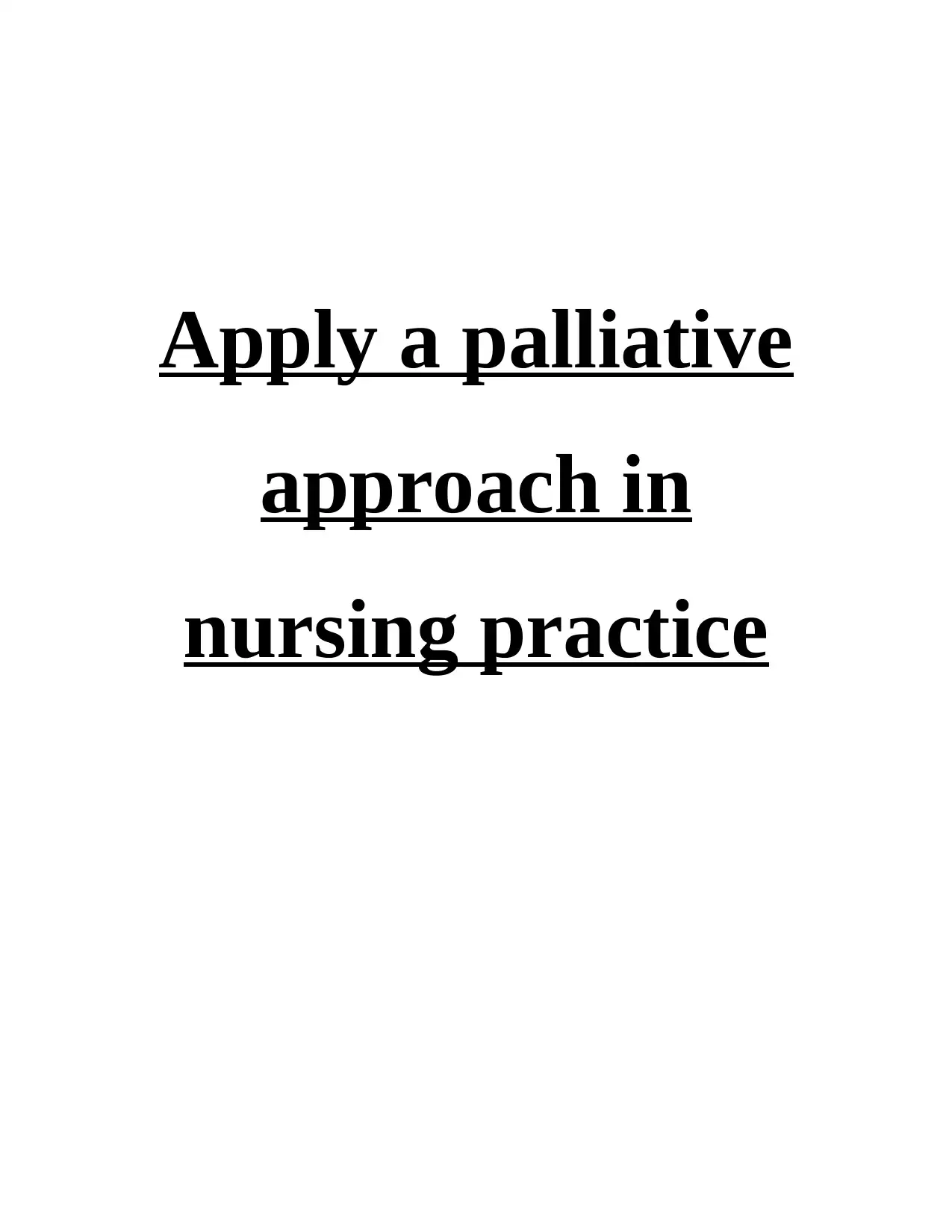
Apply a palliative
approach in
nursing practice
approach in
nursing practice
Secure Best Marks with AI Grader
Need help grading? Try our AI Grader for instant feedback on your assignments.
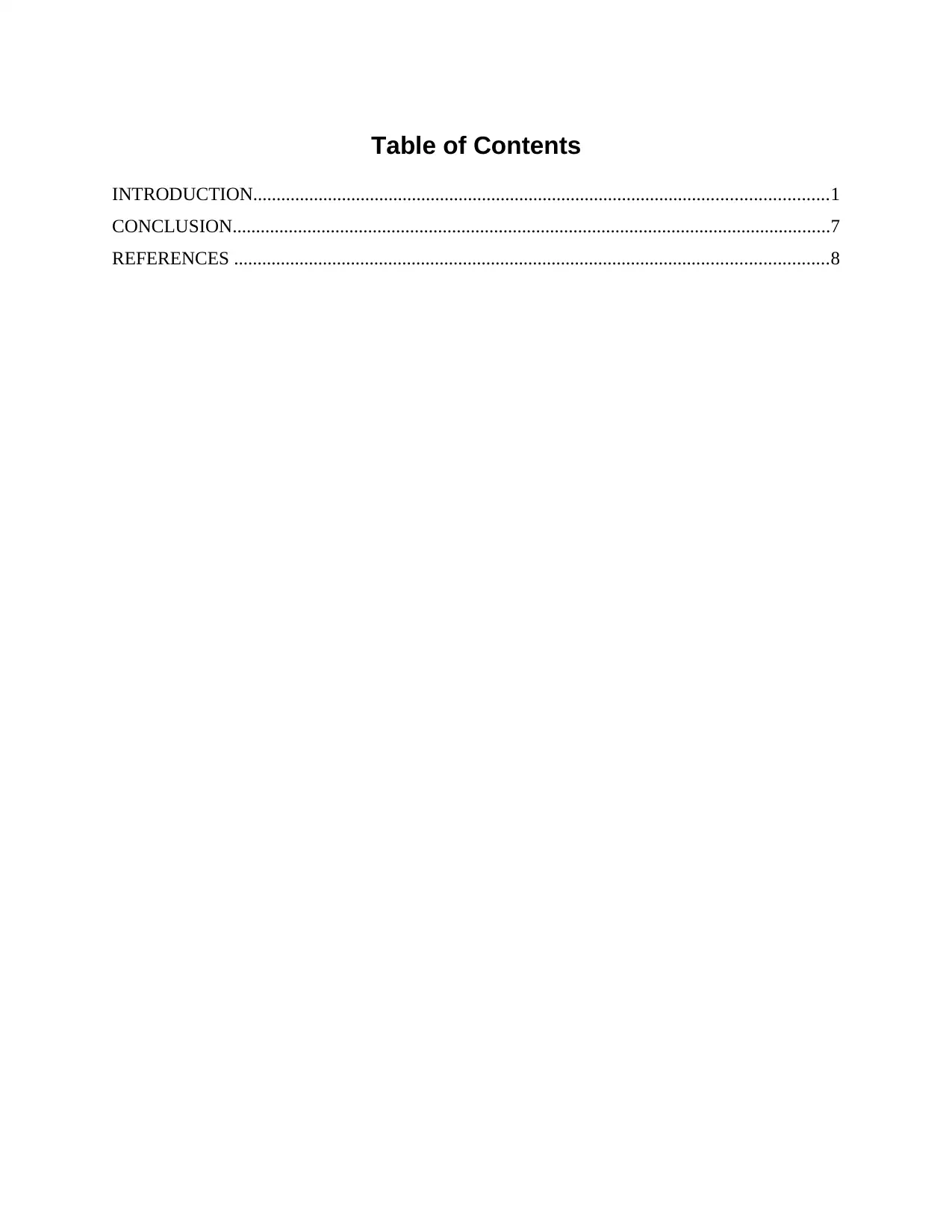
Table of Contents
INTRODUCTION...........................................................................................................................1
CONCLUSION................................................................................................................................7
REFERENCES ...............................................................................................................................8
INTRODUCTION...........................................................................................................................1
CONCLUSION................................................................................................................................7
REFERENCES ...............................................................................................................................8
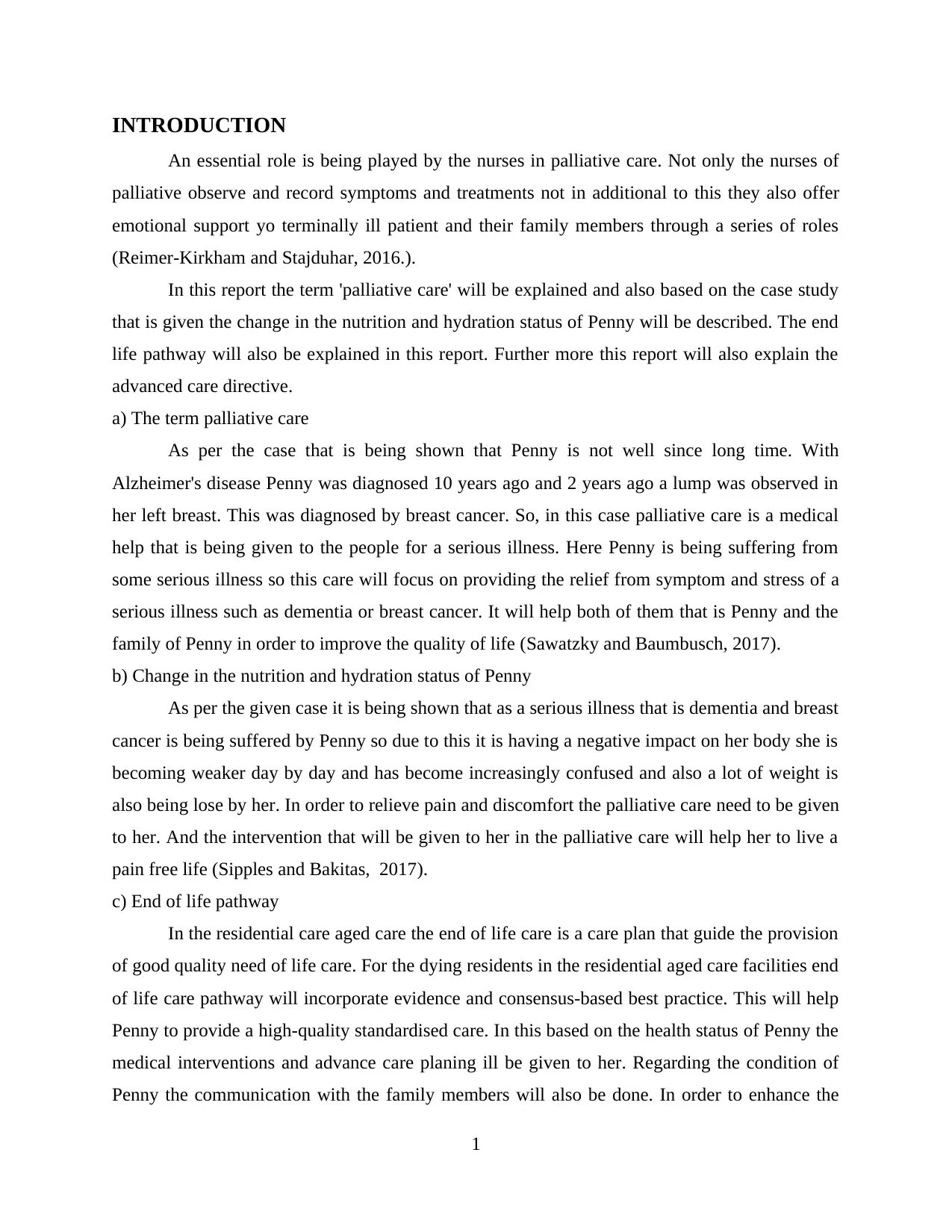
INTRODUCTION
An essential role is being played by the nurses in palliative care. Not only the nurses of
palliative observe and record symptoms and treatments not in additional to this they also offer
emotional support yo terminally ill patient and their family members through a series of roles
(Reimer‐Kirkham and Stajduhar, 2016.).
In this report the term 'palliative care' will be explained and also based on the case study
that is given the change in the nutrition and hydration status of Penny will be described. The end
life pathway will also be explained in this report. Further more this report will also explain the
advanced care directive.
a) The term palliative care
As per the case that is being shown that Penny is not well since long time. With
Alzheimer's disease Penny was diagnosed 10 years ago and 2 years ago a lump was observed in
her left breast. This was diagnosed by breast cancer. So, in this case palliative care is a medical
help that is being given to the people for a serious illness. Here Penny is being suffering from
some serious illness so this care will focus on providing the relief from symptom and stress of a
serious illness such as dementia or breast cancer. It will help both of them that is Penny and the
family of Penny in order to improve the quality of life (Sawatzky and Baumbusch, 2017).
b) Change in the nutrition and hydration status of Penny
As per the given case it is being shown that as a serious illness that is dementia and breast
cancer is being suffered by Penny so due to this it is having a negative impact on her body she is
becoming weaker day by day and has become increasingly confused and also a lot of weight is
also being lose by her. In order to relieve pain and discomfort the palliative care need to be given
to her. And the intervention that will be given to her in the palliative care will help her to live a
pain free life (Sipples and Bakitas, 2017).
c) End of life pathway
In the residential care aged care the end of life care is a care plan that guide the provision
of good quality need of life care. For the dying residents in the residential aged care facilities end
of life care pathway will incorporate evidence and consensus-based best practice. This will help
Penny to provide a high-quality standardised care. In this based on the health status of Penny the
medical interventions and advance care planing ill be given to her. Regarding the condition of
Penny the communication with the family members will also be done. In order to enhance the
1
An essential role is being played by the nurses in palliative care. Not only the nurses of
palliative observe and record symptoms and treatments not in additional to this they also offer
emotional support yo terminally ill patient and their family members through a series of roles
(Reimer‐Kirkham and Stajduhar, 2016.).
In this report the term 'palliative care' will be explained and also based on the case study
that is given the change in the nutrition and hydration status of Penny will be described. The end
life pathway will also be explained in this report. Further more this report will also explain the
advanced care directive.
a) The term palliative care
As per the case that is being shown that Penny is not well since long time. With
Alzheimer's disease Penny was diagnosed 10 years ago and 2 years ago a lump was observed in
her left breast. This was diagnosed by breast cancer. So, in this case palliative care is a medical
help that is being given to the people for a serious illness. Here Penny is being suffering from
some serious illness so this care will focus on providing the relief from symptom and stress of a
serious illness such as dementia or breast cancer. It will help both of them that is Penny and the
family of Penny in order to improve the quality of life (Sawatzky and Baumbusch, 2017).
b) Change in the nutrition and hydration status of Penny
As per the given case it is being shown that as a serious illness that is dementia and breast
cancer is being suffered by Penny so due to this it is having a negative impact on her body she is
becoming weaker day by day and has become increasingly confused and also a lot of weight is
also being lose by her. In order to relieve pain and discomfort the palliative care need to be given
to her. And the intervention that will be given to her in the palliative care will help her to live a
pain free life (Sipples and Bakitas, 2017).
c) End of life pathway
In the residential care aged care the end of life care is a care plan that guide the provision
of good quality need of life care. For the dying residents in the residential aged care facilities end
of life care pathway will incorporate evidence and consensus-based best practice. This will help
Penny to provide a high-quality standardised care. In this based on the health status of Penny the
medical interventions and advance care planing ill be given to her. Regarding the condition of
Penny the communication with the family members will also be done. In order to enhance the
1
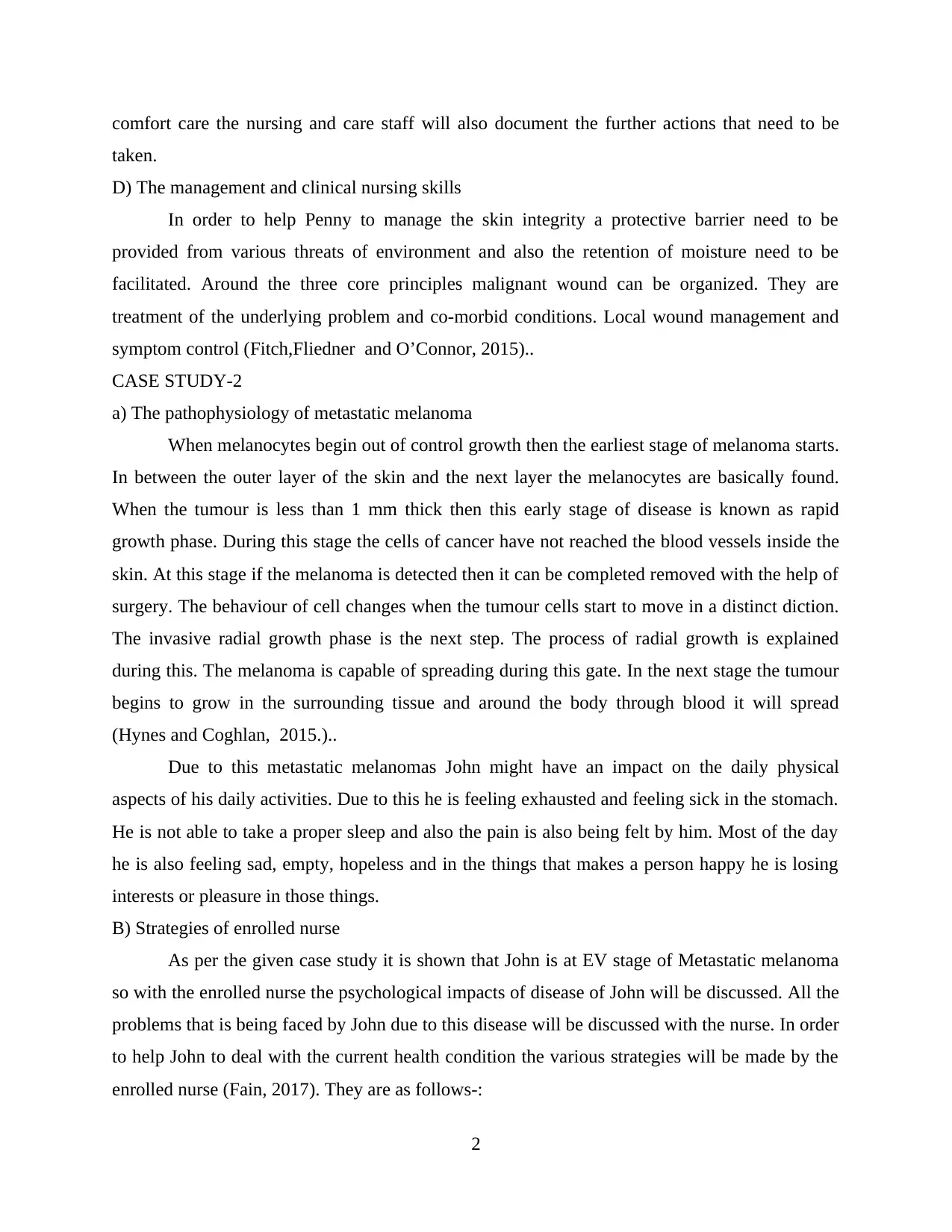
comfort care the nursing and care staff will also document the further actions that need to be
taken.
D) The management and clinical nursing skills
In order to help Penny to manage the skin integrity a protective barrier need to be
provided from various threats of environment and also the retention of moisture need to be
facilitated. Around the three core principles malignant wound can be organized. They are
treatment of the underlying problem and co-morbid conditions. Local wound management and
symptom control (Fitch,Fliedner and O’Connor, 2015)..
CASE STUDY-2
a) The pathophysiology of metastatic melanoma
When melanocytes begin out of control growth then the earliest stage of melanoma starts.
In between the outer layer of the skin and the next layer the melanocytes are basically found.
When the tumour is less than 1 mm thick then this early stage of disease is known as rapid
growth phase. During this stage the cells of cancer have not reached the blood vessels inside the
skin. At this stage if the melanoma is detected then it can be completed removed with the help of
surgery. The behaviour of cell changes when the tumour cells start to move in a distinct diction.
The invasive radial growth phase is the next step. The process of radial growth is explained
during this. The melanoma is capable of spreading during this gate. In the next stage the tumour
begins to grow in the surrounding tissue and around the body through blood it will spread
(Hynes and Coghlan, 2015.)..
Due to this metastatic melanomas John might have an impact on the daily physical
aspects of his daily activities. Due to this he is feeling exhausted and feeling sick in the stomach.
He is not able to take a proper sleep and also the pain is also being felt by him. Most of the day
he is also feeling sad, empty, hopeless and in the things that makes a person happy he is losing
interests or pleasure in those things.
B) Strategies of enrolled nurse
As per the given case study it is shown that John is at EV stage of Metastatic melanoma
so with the enrolled nurse the psychological impacts of disease of John will be discussed. All the
problems that is being faced by John due to this disease will be discussed with the nurse. In order
to help John to deal with the current health condition the various strategies will be made by the
enrolled nurse (Fain, 2017). They are as follows-:
2
taken.
D) The management and clinical nursing skills
In order to help Penny to manage the skin integrity a protective barrier need to be
provided from various threats of environment and also the retention of moisture need to be
facilitated. Around the three core principles malignant wound can be organized. They are
treatment of the underlying problem and co-morbid conditions. Local wound management and
symptom control (Fitch,Fliedner and O’Connor, 2015)..
CASE STUDY-2
a) The pathophysiology of metastatic melanoma
When melanocytes begin out of control growth then the earliest stage of melanoma starts.
In between the outer layer of the skin and the next layer the melanocytes are basically found.
When the tumour is less than 1 mm thick then this early stage of disease is known as rapid
growth phase. During this stage the cells of cancer have not reached the blood vessels inside the
skin. At this stage if the melanoma is detected then it can be completed removed with the help of
surgery. The behaviour of cell changes when the tumour cells start to move in a distinct diction.
The invasive radial growth phase is the next step. The process of radial growth is explained
during this. The melanoma is capable of spreading during this gate. In the next stage the tumour
begins to grow in the surrounding tissue and around the body through blood it will spread
(Hynes and Coghlan, 2015.)..
Due to this metastatic melanomas John might have an impact on the daily physical
aspects of his daily activities. Due to this he is feeling exhausted and feeling sick in the stomach.
He is not able to take a proper sleep and also the pain is also being felt by him. Most of the day
he is also feeling sad, empty, hopeless and in the things that makes a person happy he is losing
interests or pleasure in those things.
B) Strategies of enrolled nurse
As per the given case study it is shown that John is at EV stage of Metastatic melanoma
so with the enrolled nurse the psychological impacts of disease of John will be discussed. All the
problems that is being faced by John due to this disease will be discussed with the nurse. In order
to help John to deal with the current health condition the various strategies will be made by the
enrolled nurse (Fain, 2017). They are as follows-:
2
Secure Best Marks with AI Grader
Need help grading? Try our AI Grader for instant feedback on your assignments.
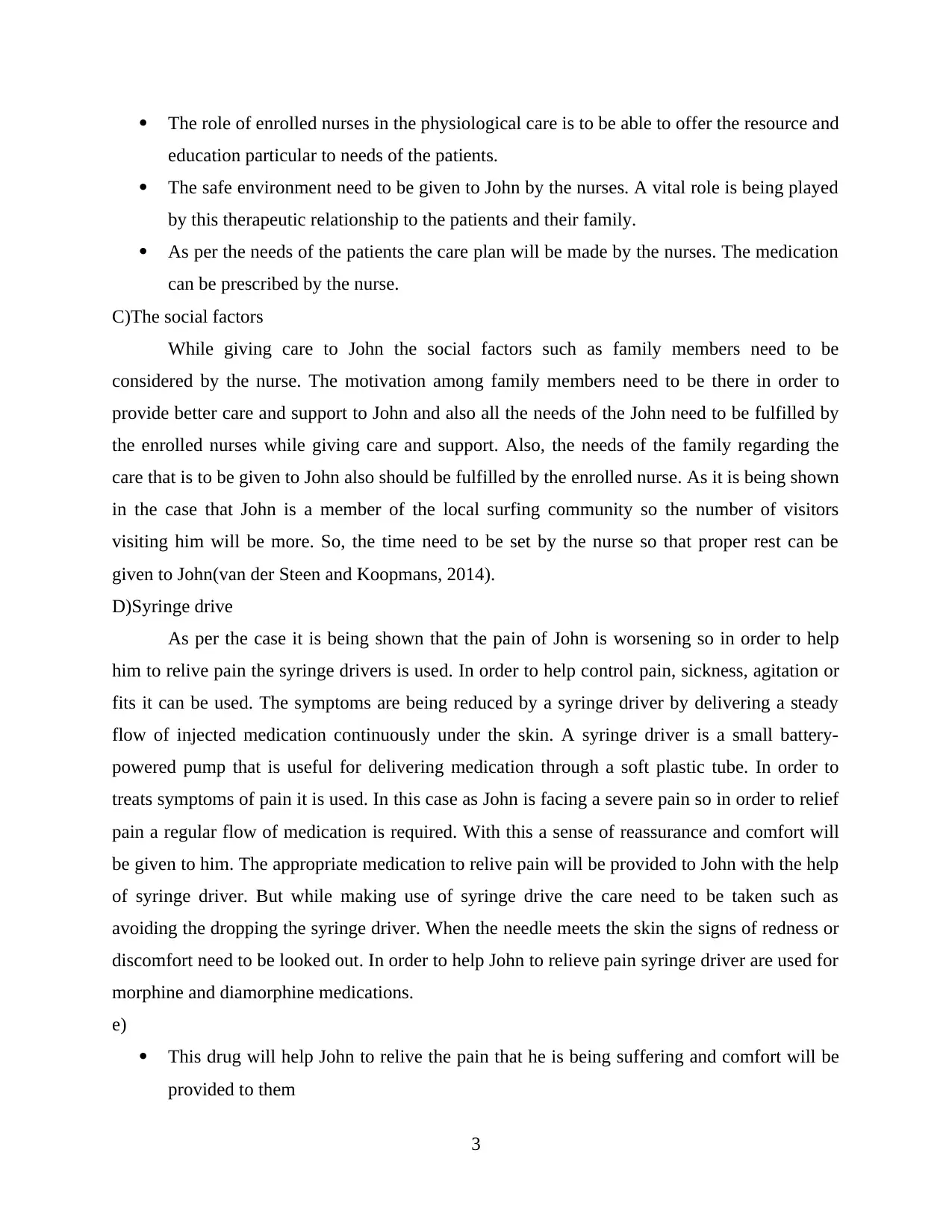
The role of enrolled nurses in the physiological care is to be able to offer the resource and
education particular to needs of the patients.
The safe environment need to be given to John by the nurses. A vital role is being played
by this therapeutic relationship to the patients and their family.
As per the needs of the patients the care plan will be made by the nurses. The medication
can be prescribed by the nurse.
C)The social factors
While giving care to John the social factors such as family members need to be
considered by the nurse. The motivation among family members need to be there in order to
provide better care and support to John and also all the needs of the John need to be fulfilled by
the enrolled nurses while giving care and support. Also, the needs of the family regarding the
care that is to be given to John also should be fulfilled by the enrolled nurse. As it is being shown
in the case that John is a member of the local surfing community so the number of visitors
visiting him will be more. So, the time need to be set by the nurse so that proper rest can be
given to John(van der Steen and Koopmans, 2014).
D)Syringe drive
As per the case it is being shown that the pain of John is worsening so in order to help
him to relive pain the syringe drivers is used. In order to help control pain, sickness, agitation or
fits it can be used. The symptoms are being reduced by a syringe driver by delivering a steady
flow of injected medication continuously under the skin. A syringe driver is a small battery-
powered pump that is useful for delivering medication through a soft plastic tube. In order to
treats symptoms of pain it is used. In this case as John is facing a severe pain so in order to relief
pain a regular flow of medication is required. With this a sense of reassurance and comfort will
be given to him. The appropriate medication to relive pain will be provided to John with the help
of syringe driver. But while making use of syringe drive the care need to be taken such as
avoiding the dropping the syringe driver. When the needle meets the skin the signs of redness or
discomfort need to be looked out. In order to help John to relieve pain syringe driver are used for
morphine and diamorphine medications.
e)
This drug will help John to relive the pain that he is being suffering and comfort will be
provided to them
3
education particular to needs of the patients.
The safe environment need to be given to John by the nurses. A vital role is being played
by this therapeutic relationship to the patients and their family.
As per the needs of the patients the care plan will be made by the nurses. The medication
can be prescribed by the nurse.
C)The social factors
While giving care to John the social factors such as family members need to be
considered by the nurse. The motivation among family members need to be there in order to
provide better care and support to John and also all the needs of the John need to be fulfilled by
the enrolled nurses while giving care and support. Also, the needs of the family regarding the
care that is to be given to John also should be fulfilled by the enrolled nurse. As it is being shown
in the case that John is a member of the local surfing community so the number of visitors
visiting him will be more. So, the time need to be set by the nurse so that proper rest can be
given to John(van der Steen and Koopmans, 2014).
D)Syringe drive
As per the case it is being shown that the pain of John is worsening so in order to help
him to relive pain the syringe drivers is used. In order to help control pain, sickness, agitation or
fits it can be used. The symptoms are being reduced by a syringe driver by delivering a steady
flow of injected medication continuously under the skin. A syringe driver is a small battery-
powered pump that is useful for delivering medication through a soft plastic tube. In order to
treats symptoms of pain it is used. In this case as John is facing a severe pain so in order to relief
pain a regular flow of medication is required. With this a sense of reassurance and comfort will
be given to him. The appropriate medication to relive pain will be provided to John with the help
of syringe driver. But while making use of syringe drive the care need to be taken such as
avoiding the dropping the syringe driver. When the needle meets the skin the signs of redness or
discomfort need to be looked out. In order to help John to relieve pain syringe driver are used for
morphine and diamorphine medications.
e)
This drug will help John to relive the pain that he is being suffering and comfort will be
provided to them
3

The two side effect can be constipation and dizziness. In order to prevent this
constipation John need to consume an adequate diet in fibre and drink plenty of water.
And in order to reduce the risk of dizziness John need to get up slowly from lying or
sitting position (Reimer-Kirkham and Wikjord, 2015).
F) 5 Nursing action
Assessment of pain
The root of the problem will be identified
Planning the care
Administration of medication
Evaluation of effectiveness.
Case-3
a) The family and relationship structure
By the challenges of illness the families of patient receiving palliative care are affected
profoundly. The care that is being received by the patient is observed by them and in the form of
information, counselling the families of patient also receive the support from health
professionals. The quality of care that is given to the patients is being observed by them as they
witness and involved in the care of patients. The support to the family members is being by the
palliative care (Price and Luo, 2015).
b) The cultural significant beliefs
For an individual culture and belief a respectful environment need to be given in the
palliative care. The respect and equal treatment to all the patients need to be given by this care.
From the person's cultural perspective meaning of death and dying need to be understand by the
culturally appropriate palliative care. In case if the patient is not able to communicate properly in
English then the translator can be used or the written communication can be used for the
treatment by the palliative care.
Case-4
The cultural protocol and tradition will be kept in mind while giving care to specific
patients (Nelson and Staggers, 2016). During the palliative care and after death it is essential that
tradition and culture of the person need to be admired. For an instance for the Aboriginal and
Torres stressor islanders they may have different cultural practices. For them the topic of death is
4
constipation John need to consume an adequate diet in fibre and drink plenty of water.
And in order to reduce the risk of dizziness John need to get up slowly from lying or
sitting position (Reimer-Kirkham and Wikjord, 2015).
F) 5 Nursing action
Assessment of pain
The root of the problem will be identified
Planning the care
Administration of medication
Evaluation of effectiveness.
Case-3
a) The family and relationship structure
By the challenges of illness the families of patient receiving palliative care are affected
profoundly. The care that is being received by the patient is observed by them and in the form of
information, counselling the families of patient also receive the support from health
professionals. The quality of care that is given to the patients is being observed by them as they
witness and involved in the care of patients. The support to the family members is being by the
palliative care (Price and Luo, 2015).
b) The cultural significant beliefs
For an individual culture and belief a respectful environment need to be given in the
palliative care. The respect and equal treatment to all the patients need to be given by this care.
From the person's cultural perspective meaning of death and dying need to be understand by the
culturally appropriate palliative care. In case if the patient is not able to communicate properly in
English then the translator can be used or the written communication can be used for the
treatment by the palliative care.
Case-4
The cultural protocol and tradition will be kept in mind while giving care to specific
patients (Nelson and Staggers, 2016). During the palliative care and after death it is essential that
tradition and culture of the person need to be admired. For an instance for the Aboriginal and
Torres stressor islanders they may have different cultural practices. For them the topic of death is
4
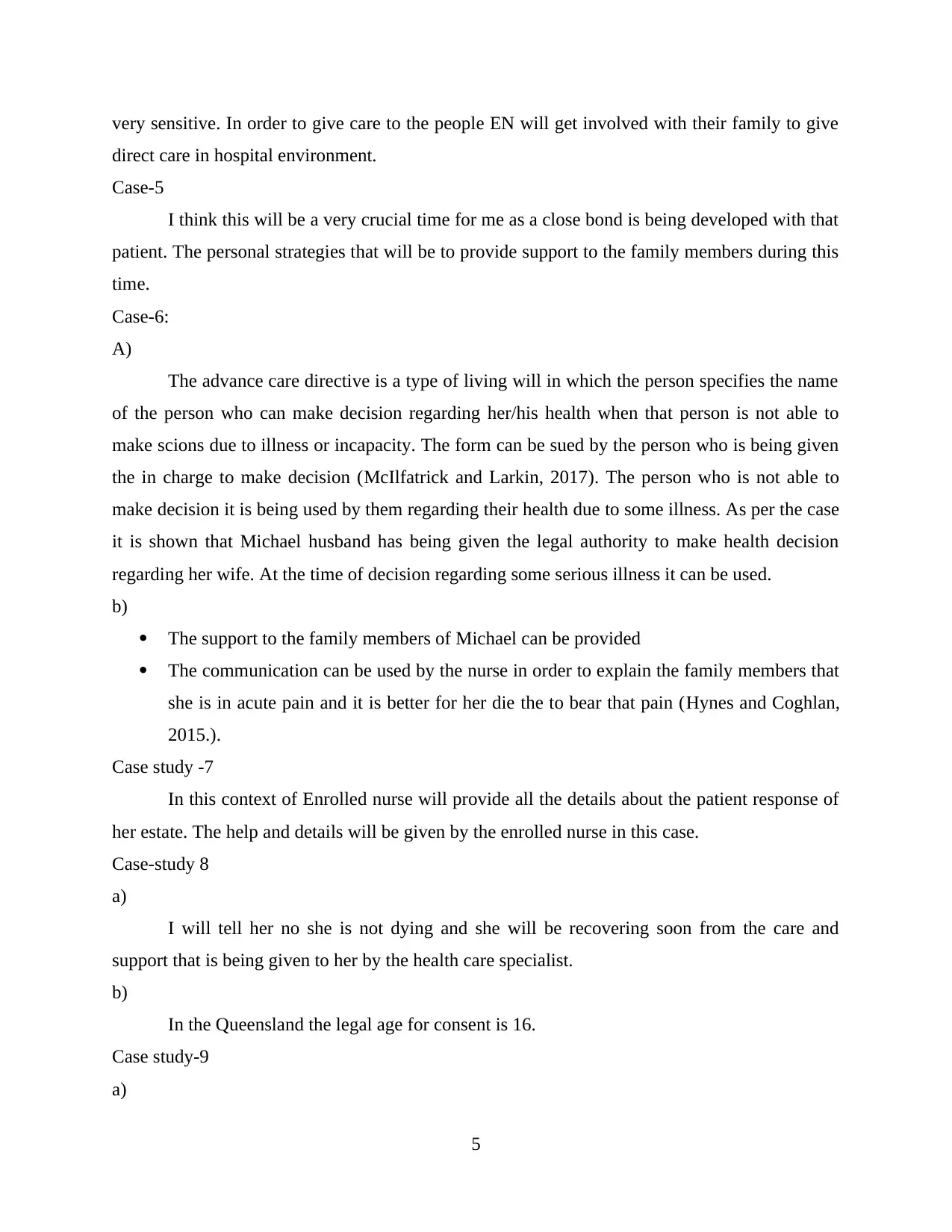
very sensitive. In order to give care to the people EN will get involved with their family to give
direct care in hospital environment.
Case-5
I think this will be a very crucial time for me as a close bond is being developed with that
patient. The personal strategies that will be to provide support to the family members during this
time.
Case-6:
A)
The advance care directive is a type of living will in which the person specifies the name
of the person who can make decision regarding her/his health when that person is not able to
make scions due to illness or incapacity. The form can be sued by the person who is being given
the in charge to make decision (McIlfatrick and Larkin, 2017). The person who is not able to
make decision it is being used by them regarding their health due to some illness. As per the case
it is shown that Michael husband has being given the legal authority to make health decision
regarding her wife. At the time of decision regarding some serious illness it can be used.
b)
The support to the family members of Michael can be provided
The communication can be used by the nurse in order to explain the family members that
she is in acute pain and it is better for her die the to bear that pain (Hynes and Coghlan,
2015.).
Case study -7
In this context of Enrolled nurse will provide all the details about the patient response of
her estate. The help and details will be given by the enrolled nurse in this case.
Case-study 8
a)
I will tell her no she is not dying and she will be recovering soon from the care and
support that is being given to her by the health care specialist.
b)
In the Queensland the legal age for consent is 16.
Case study-9
a)
5
direct care in hospital environment.
Case-5
I think this will be a very crucial time for me as a close bond is being developed with that
patient. The personal strategies that will be to provide support to the family members during this
time.
Case-6:
A)
The advance care directive is a type of living will in which the person specifies the name
of the person who can make decision regarding her/his health when that person is not able to
make scions due to illness or incapacity. The form can be sued by the person who is being given
the in charge to make decision (McIlfatrick and Larkin, 2017). The person who is not able to
make decision it is being used by them regarding their health due to some illness. As per the case
it is shown that Michael husband has being given the legal authority to make health decision
regarding her wife. At the time of decision regarding some serious illness it can be used.
b)
The support to the family members of Michael can be provided
The communication can be used by the nurse in order to explain the family members that
she is in acute pain and it is better for her die the to bear that pain (Hynes and Coghlan,
2015.).
Case study -7
In this context of Enrolled nurse will provide all the details about the patient response of
her estate. The help and details will be given by the enrolled nurse in this case.
Case-study 8
a)
I will tell her no she is not dying and she will be recovering soon from the care and
support that is being given to her by the health care specialist.
b)
In the Queensland the legal age for consent is 16.
Case study-9
a)
5
Paraphrase This Document
Need a fresh take? Get an instant paraphrase of this document with our AI Paraphraser
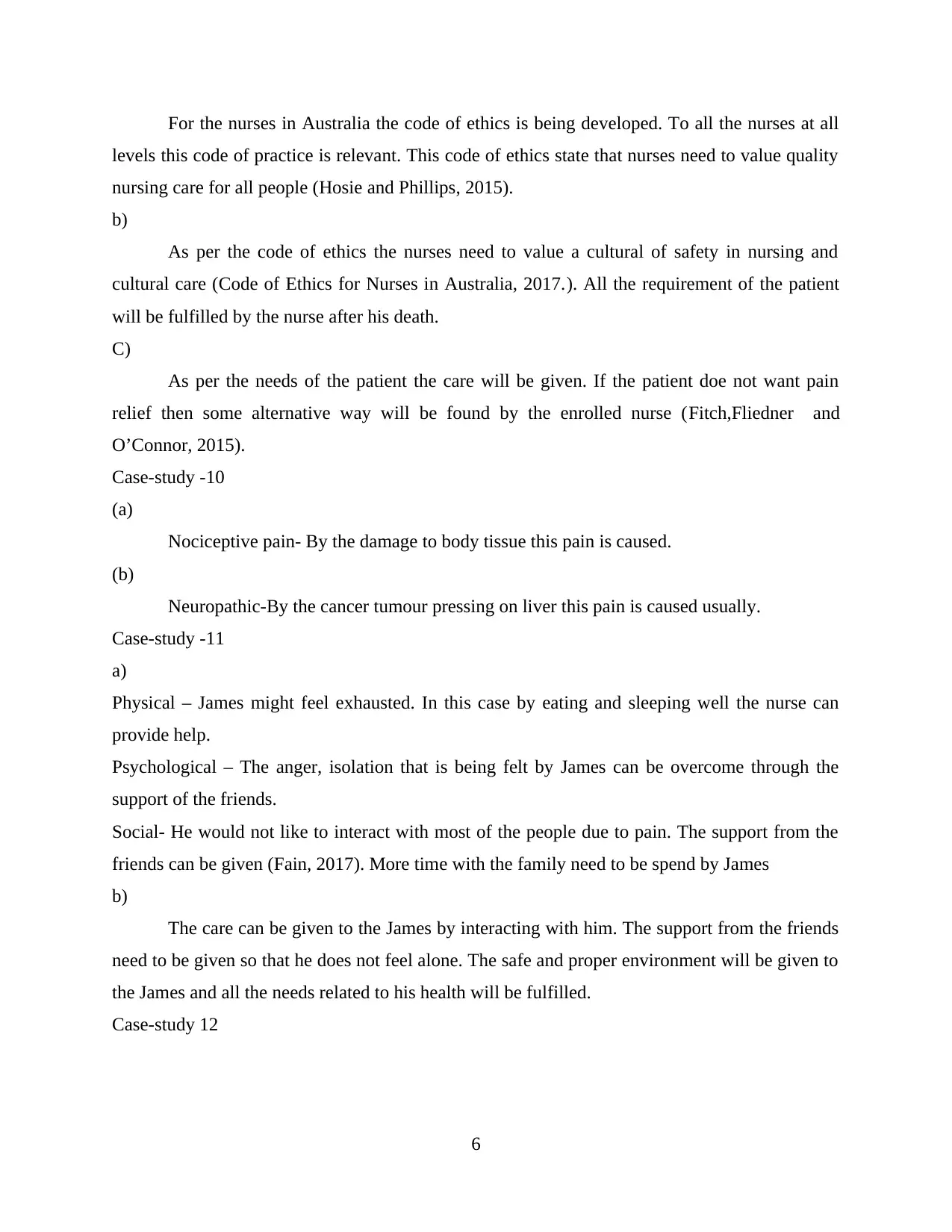
For the nurses in Australia the code of ethics is being developed. To all the nurses at all
levels this code of practice is relevant. This code of ethics state that nurses need to value quality
nursing care for all people (Hosie and Phillips, 2015).
b)
As per the code of ethics the nurses need to value a cultural of safety in nursing and
cultural care (Code of Ethics for Nurses in Australia, 2017.). All the requirement of the patient
will be fulfilled by the nurse after his death.
C)
As per the needs of the patient the care will be given. If the patient doe not want pain
relief then some alternative way will be found by the enrolled nurse (Fitch,Fliedner and
O’Connor, 2015).
Case-study -10
(a)
Nociceptive pain- By the damage to body tissue this pain is caused.
(b)
Neuropathic-By the cancer tumour pressing on liver this pain is caused usually.
Case-study -11
a)
Physical – James might feel exhausted. In this case by eating and sleeping well the nurse can
provide help.
Psychological – The anger, isolation that is being felt by James can be overcome through the
support of the friends.
Social- He would not like to interact with most of the people due to pain. The support from the
friends can be given (Fain, 2017). More time with the family need to be spend by James
b)
The care can be given to the James by interacting with him. The support from the friends
need to be given so that he does not feel alone. The safe and proper environment will be given to
the James and all the needs related to his health will be fulfilled.
Case-study 12
6
levels this code of practice is relevant. This code of ethics state that nurses need to value quality
nursing care for all people (Hosie and Phillips, 2015).
b)
As per the code of ethics the nurses need to value a cultural of safety in nursing and
cultural care (Code of Ethics for Nurses in Australia, 2017.). All the requirement of the patient
will be fulfilled by the nurse after his death.
C)
As per the needs of the patient the care will be given. If the patient doe not want pain
relief then some alternative way will be found by the enrolled nurse (Fitch,Fliedner and
O’Connor, 2015).
Case-study -10
(a)
Nociceptive pain- By the damage to body tissue this pain is caused.
(b)
Neuropathic-By the cancer tumour pressing on liver this pain is caused usually.
Case-study -11
a)
Physical – James might feel exhausted. In this case by eating and sleeping well the nurse can
provide help.
Psychological – The anger, isolation that is being felt by James can be overcome through the
support of the friends.
Social- He would not like to interact with most of the people due to pain. The support from the
friends can be given (Fain, 2017). More time with the family need to be spend by James
b)
The care can be given to the James by interacting with him. The support from the friends
need to be given so that he does not feel alone. The safe and proper environment will be given to
the James and all the needs related to his health will be fulfilled.
Case-study 12
6

With the family members of this indigenous group the final arrangement will be
discussed. Based on their culture and religious beliefs all the arrangement will be done by the
EN.
Case-study 13
a)
The interpreter service is needed as the brother arrive recently form their native country.
In order to make aware about what EN is saying a translator is needed.
b)
With the family members the final arrangement will be discussed
The healthy diet will be given to the patient such fruits, green vegetable etc will be given
before death. And also the family will be informed about the condition of the patient so
that they get time to make themselves ready. And after the death the support will be given
by EN to the family of patients (Bryant‐Lukosius and Schwendimann, 2016.).
Case-study-14
a)\
Other than the family members the enrolled nurse need to be informed about the death of
the patient.
b)
The information can be given to the family that situation was getting worse for the patient
so for her/his it was better to die then to live in that situation.
The support can also be given to them through inspirational words
Case-study -15
A death certificate determines that the person is deceased
By a pathologist an autopsy is done usually.
Case -study -16
When the person is died the organ and tissue donation involves removable of organs and
tissues form his/her body and then it is being transplanted into someone who is ill or dying. The
organs such as heart, liver etc can be transplanted (Beck, Jakobsson and Edberg, 2015).
CONCLUSION
Thus summing up the above report it can be concluded that in order to provide comfort to
the patient from the pain syringe drive can be used. The code of ethics states that EN need to
7
discussed. Based on their culture and religious beliefs all the arrangement will be done by the
EN.
Case-study 13
a)
The interpreter service is needed as the brother arrive recently form their native country.
In order to make aware about what EN is saying a translator is needed.
b)
With the family members the final arrangement will be discussed
The healthy diet will be given to the patient such fruits, green vegetable etc will be given
before death. And also the family will be informed about the condition of the patient so
that they get time to make themselves ready. And after the death the support will be given
by EN to the family of patients (Bryant‐Lukosius and Schwendimann, 2016.).
Case-study-14
a)\
Other than the family members the enrolled nurse need to be informed about the death of
the patient.
b)
The information can be given to the family that situation was getting worse for the patient
so for her/his it was better to die then to live in that situation.
The support can also be given to them through inspirational words
Case-study -15
A death certificate determines that the person is deceased
By a pathologist an autopsy is done usually.
Case -study -16
When the person is died the organ and tissue donation involves removable of organs and
tissues form his/her body and then it is being transplanted into someone who is ill or dying. The
organs such as heart, liver etc can be transplanted (Beck, Jakobsson and Edberg, 2015).
CONCLUSION
Thus summing up the above report it can be concluded that in order to provide comfort to
the patient from the pain syringe drive can be used. The code of ethics states that EN need to
7
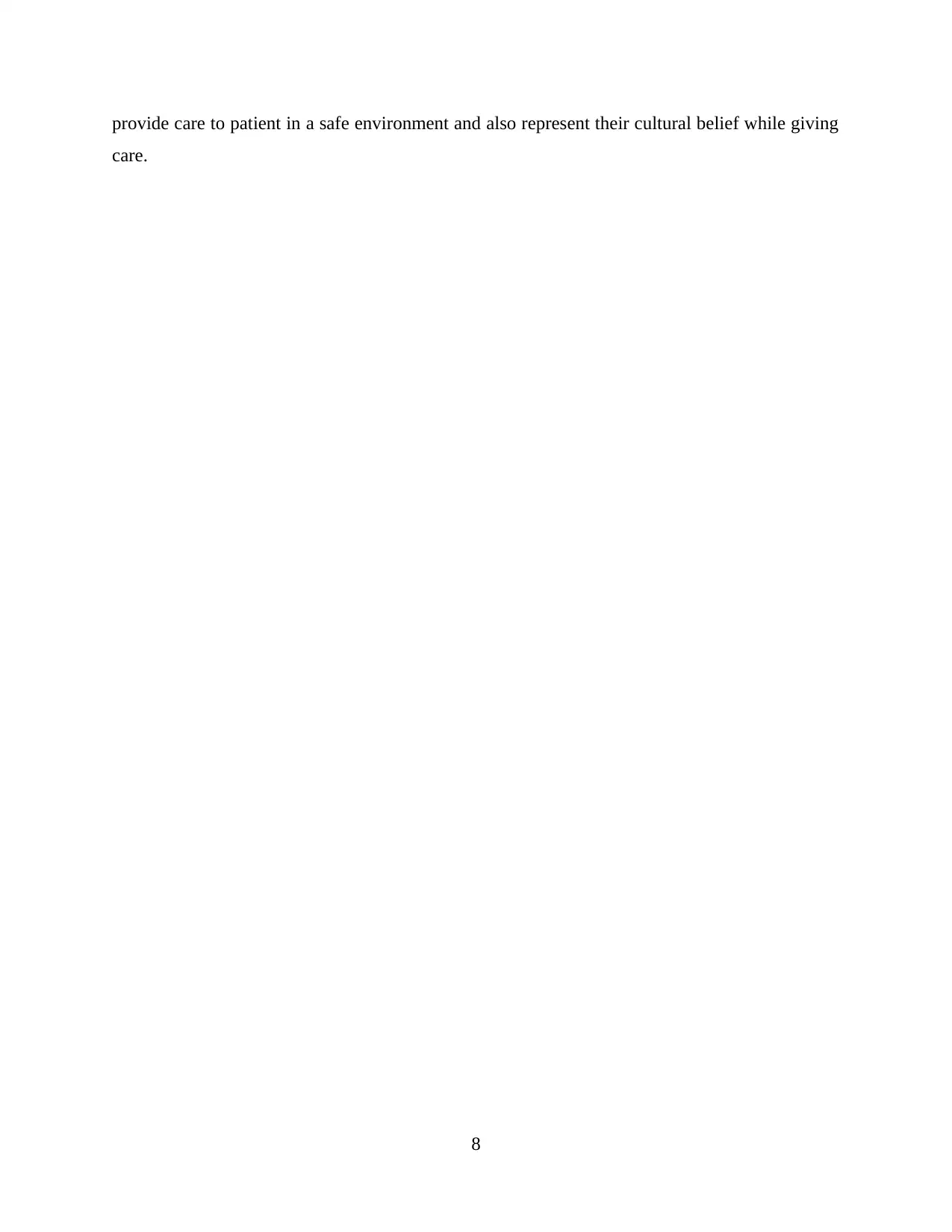
provide care to patient in a safe environment and also represent their cultural belief while giving
care.
8
care.
8
Secure Best Marks with AI Grader
Need help grading? Try our AI Grader for instant feedback on your assignments.
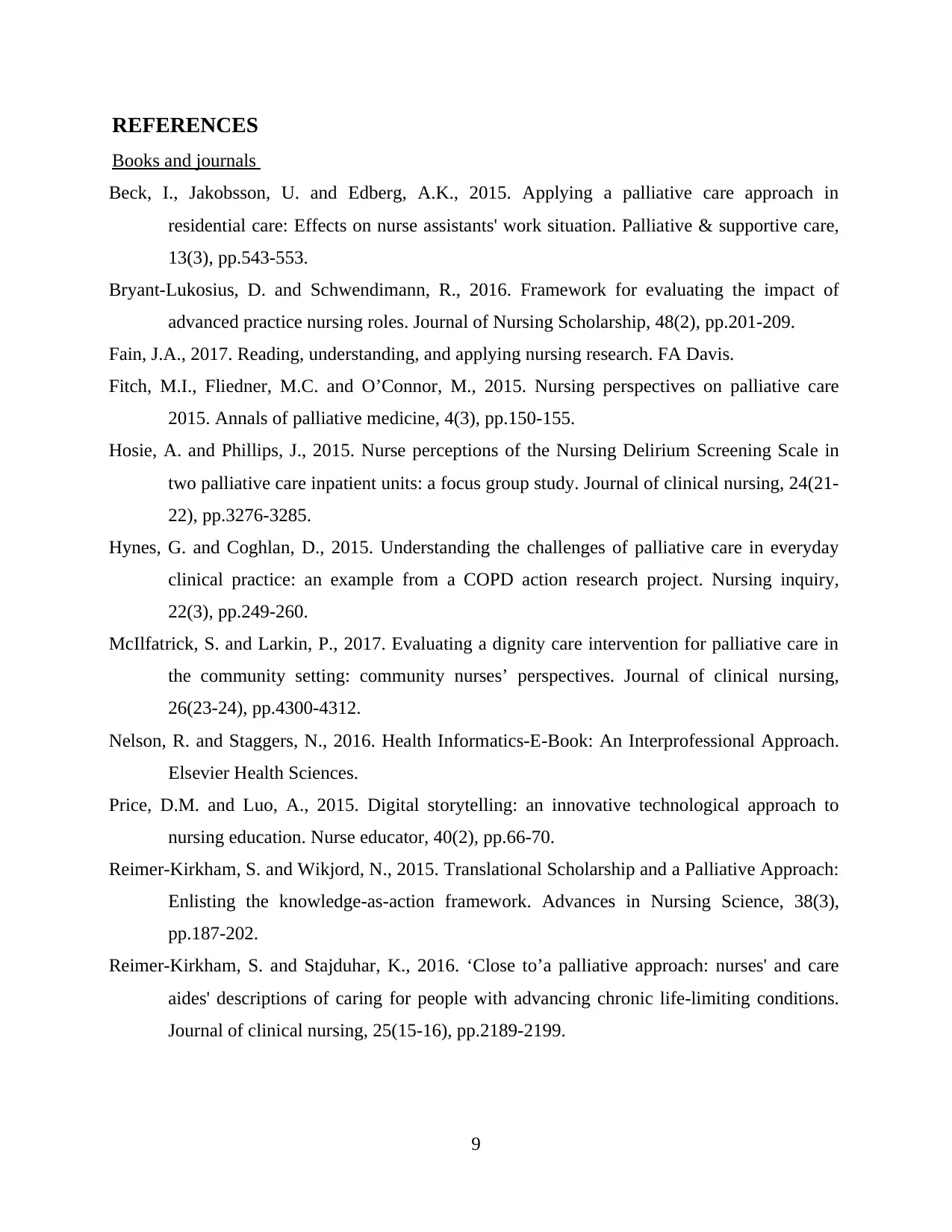
REFERENCES
Books and journals
Beck, I., Jakobsson, U. and Edberg, A.K., 2015. Applying a palliative care approach in
residential care: Effects on nurse assistants' work situation. Palliative & supportive care,
13(3), pp.543-553.
Bryant‐Lukosius, D. and Schwendimann, R., 2016. Framework for evaluating the impact of
advanced practice nursing roles. Journal of Nursing Scholarship, 48(2), pp.201-209.
Fain, J.A., 2017. Reading, understanding, and applying nursing research. FA Davis.
Fitch, M.I., Fliedner, M.C. and O’Connor, M., 2015. Nursing perspectives on palliative care
2015. Annals of palliative medicine, 4(3), pp.150-155.
Hosie, A. and Phillips, J., 2015. Nurse perceptions of the Nursing Delirium Screening Scale in
two palliative care inpatient units: a focus group study. Journal of clinical nursing, 24(21-
22), pp.3276-3285.
Hynes, G. and Coghlan, D., 2015. Understanding the challenges of palliative care in everyday
clinical practice: an example from a COPD action research project. Nursing inquiry,
22(3), pp.249-260.
McIlfatrick, S. and Larkin, P., 2017. Evaluating a dignity care intervention for palliative care in
the community setting: community nurses’ perspectives. Journal of clinical nursing,
26(23-24), pp.4300-4312.
Nelson, R. and Staggers, N., 2016. Health Informatics-E-Book: An Interprofessional Approach.
Elsevier Health Sciences.
Price, D.M. and Luo, A., 2015. Digital storytelling: an innovative technological approach to
nursing education. Nurse educator, 40(2), pp.66-70.
Reimer-Kirkham, S. and Wikjord, N., 2015. Translational Scholarship and a Palliative Approach:
Enlisting the knowledge-as-action framework. Advances in Nursing Science, 38(3),
pp.187-202.
Reimer‐Kirkham, S. and Stajduhar, K., 2016. ‘Close to’a palliative approach: nurses' and care
aides' descriptions of caring for people with advancing chronic life‐limiting conditions.
Journal of clinical nursing, 25(15-16), pp.2189-2199.
9
Books and journals
Beck, I., Jakobsson, U. and Edberg, A.K., 2015. Applying a palliative care approach in
residential care: Effects on nurse assistants' work situation. Palliative & supportive care,
13(3), pp.543-553.
Bryant‐Lukosius, D. and Schwendimann, R., 2016. Framework for evaluating the impact of
advanced practice nursing roles. Journal of Nursing Scholarship, 48(2), pp.201-209.
Fain, J.A., 2017. Reading, understanding, and applying nursing research. FA Davis.
Fitch, M.I., Fliedner, M.C. and O’Connor, M., 2015. Nursing perspectives on palliative care
2015. Annals of palliative medicine, 4(3), pp.150-155.
Hosie, A. and Phillips, J., 2015. Nurse perceptions of the Nursing Delirium Screening Scale in
two palliative care inpatient units: a focus group study. Journal of clinical nursing, 24(21-
22), pp.3276-3285.
Hynes, G. and Coghlan, D., 2015. Understanding the challenges of palliative care in everyday
clinical practice: an example from a COPD action research project. Nursing inquiry,
22(3), pp.249-260.
McIlfatrick, S. and Larkin, P., 2017. Evaluating a dignity care intervention for palliative care in
the community setting: community nurses’ perspectives. Journal of clinical nursing,
26(23-24), pp.4300-4312.
Nelson, R. and Staggers, N., 2016. Health Informatics-E-Book: An Interprofessional Approach.
Elsevier Health Sciences.
Price, D.M. and Luo, A., 2015. Digital storytelling: an innovative technological approach to
nursing education. Nurse educator, 40(2), pp.66-70.
Reimer-Kirkham, S. and Wikjord, N., 2015. Translational Scholarship and a Palliative Approach:
Enlisting the knowledge-as-action framework. Advances in Nursing Science, 38(3),
pp.187-202.
Reimer‐Kirkham, S. and Stajduhar, K., 2016. ‘Close to’a palliative approach: nurses' and care
aides' descriptions of caring for people with advancing chronic life‐limiting conditions.
Journal of clinical nursing, 25(15-16), pp.2189-2199.
9

Sawatzky, R. and Baumbusch, J., 2017. Embedding a palliative approach in nursing care
delivery: an integrated knowledge synthesis. ANS. Advances in nursing science, 40(3),
p.263.
Sipples, R. and Bakitas, M., 2017, February. Perioperative Palliative Care Considerations for
Surgical Oncology Nurses. In Seminars in oncology nursing (Vol. 33, No. 1, pp. 9-22).
WB Saunders.
van der Steen, J.T. and Koopmans, R.T., 2014. White paper defining optimal palliative care in
older people with dementia: a Delphi study and recommendations from the European
Association for Palliative Care. Palliative medicine, 28(3), pp.197-209.
Online
Code of Ethics for Nurses in Australia. 2017. [PDF].<file:///home/user1/Desktop/5_New-Code-
of-Ethics-for-Nurses-August-2008%20(1).PDF>
10
delivery: an integrated knowledge synthesis. ANS. Advances in nursing science, 40(3),
p.263.
Sipples, R. and Bakitas, M., 2017, February. Perioperative Palliative Care Considerations for
Surgical Oncology Nurses. In Seminars in oncology nursing (Vol. 33, No. 1, pp. 9-22).
WB Saunders.
van der Steen, J.T. and Koopmans, R.T., 2014. White paper defining optimal palliative care in
older people with dementia: a Delphi study and recommendations from the European
Association for Palliative Care. Palliative medicine, 28(3), pp.197-209.
Online
Code of Ethics for Nurses in Australia. 2017. [PDF].<file:///home/user1/Desktop/5_New-Code-
of-Ethics-for-Nurses-August-2008%20(1).PDF>
10

11
1 out of 13
Your All-in-One AI-Powered Toolkit for Academic Success.
+13062052269
info@desklib.com
Available 24*7 on WhatsApp / Email
![[object Object]](/_next/static/media/star-bottom.7253800d.svg)
Unlock your academic potential
© 2024 | Zucol Services PVT LTD | All rights reserved.





